William C. C. Chen's Tai Chi Short Form Videos
Yang-Style Short Form of Tai Chi Chuan
Channel:
Essential Sports and Fitness Videos (Tai Chi)
This collection of videos of Grandmaster Chen doing and teaching the Yang Short Form,
includes his complete Tai Chi Short Form DVD, his Body Mechanics DVD, and rare, early 8mm videos of his form.
The videos include detailed explanations that help beginners and advanced students get the most from their practice.
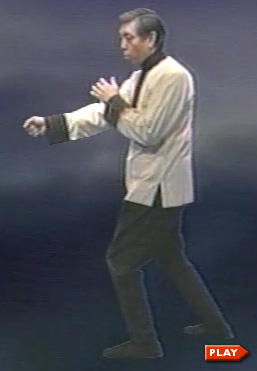
Yang Short Form - with Breathing Hints (from behind)
60 movements (variation of Cheng Man-Ching's 37 postures). (00:11:47)
Grandmaster Chen narrates alternating "wake up" and "fall asleep" instructions that correspond to the breathing and energy
pattern of the Tai Chi form. "Fall asleep" is when you exhale and relax the most (Yin), and "wake up" is when you
inhale and expand your energy (Yang).
The coordination of slow movement and deep relaxed breathing helps explain the medical research findings that the Tai Chi
martial arts form promotes blood circulation, increases the oxygen level throughout the body, and enhances the body's healing systems.
Tai Chi has a reputation not only for being safe at any age, but also of slowing the aging process itself.
From: William C. C. Chen (Short Form DVD)
To watch Tai Chi form with breath hints, from behind, click picture
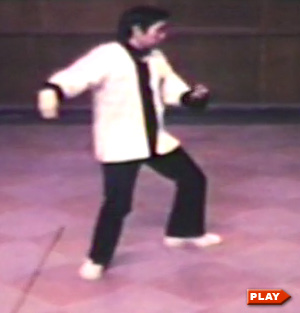
Here we see Grandmaster Chen doing portions of the Tai Chi form in one of his early New York schools (and a nearby park). (00:01:55)
He often had visitors to his school from Professor Cheng Man-Ching's school
in Chinatown, as well as local Karate schools, who came to push hands or spar. (8mm, no sound, early 1970's)
From: William C. C. Chen
To watch Grandmaster Chen's forms, click on picture
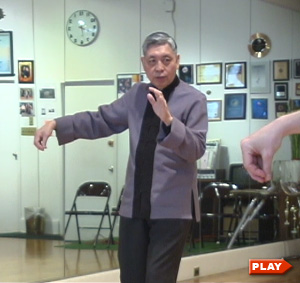
Tai Chi Form Class (2002)
Alternating between thinking and doing. (00:04:07)
This episode of Sam Masich's Taiji People series has highlights of Grandmaster Chen teaching a Yang Short Form class.
He explains how the practitioner's mental state alternates between thinking ("tilt") and doing ("no-tilt").
His focus is on making moving through the postures simple, natural, enjoyable, and productive.
From: William C. C. Chen and Sam Masich
To watch Grandmaster Chen's teach the form, click on picture
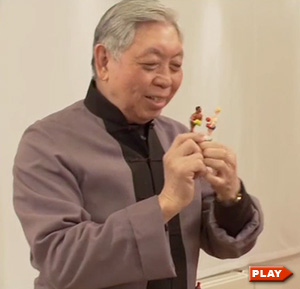
Body Mechanics of Tai Chi Chuan - Chapter 3
The role of the feet and inner thigh muscles. (00:09:34)
Grandmaster Chen explains the position of the legs, how weight is distributed,
the "three nails" of the feet, and the importance of the big toe.
He uses toy boxers to illustrate how the inner thighs play their part
and elaborates on how he made Professor Cheng Man Ching's form a little "sweeter".
From: William C. C. Chen and Nils Klug (Body Mechanics DVD)
To watch this clip, click on picture
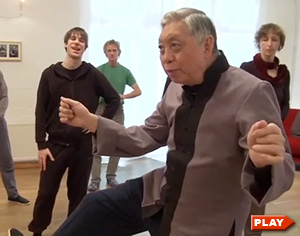
Body Mechanics of Tai Chi Chuan - Chapter 6
Tilting to gain leverage. Keeping the back straight. (00:03:28)
Grandmaster Chen explains when to tilt and the difference between keeping the body straight versus upright.
He explains why he added "needle at the bottom of the sea" (from the Yang Long Form) to the Short Form.
Finally, he demonstrates how the Tai Chi kick requires energizing the fingers ("breaking the chop sticks").
From: William C. C. Chen and Nils Klug (Body Mechanics DVD)
To watch this clip, click on picture
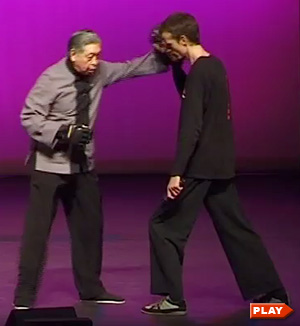
Form and Application Demo
Tai Chi Chuan as self-defense. Cheng Man-Ching Forum 2004. (00:08:08)
Grandmaster Chen and Sifu Nils Klug go through the first portion of the Yang Short Form (with a nice Sitar background).
Then Grandmaster Chen explains the relationship between slow, calm movements and martial arts.
Then he shows how speeding up particular moves of the Tai Chi form leads to an effective jab, cross, hook, roundhouse,
and uppercut.
From: William C. C. Chen and Nils Klug
To watch this clip of William Chen in action, click on picture
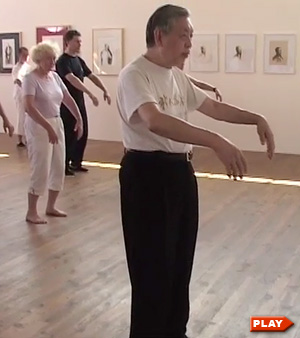
Workshop in the Body Mechanics of the Tai Chi Form
Cheng Man-Ching Forum 2004 (Hanover, Germany). (00:05:54)
Grandmaster Chen explains and shows how the breathing pattern (inhale and exhale) naturally follows the alternating
increase and decrease in the Tai Chi form of mental awareness ("waking up and falling asleep" by collapsing, sinking, and sagging).
He demonstrates the role of the big toe, ball of the foot, and heel (the "three nails") in
movement and creating spin from the ground.
From: William C. C. Chen and Nils Klug
To watch this clip of William Chen in action, click on picture
Grandmaster Chen on his "60 Movements" Tai Chi Form (2017)
|
My 60 movements are derived from Professor Cheng Man-Ching’s 37 postures.
I am using the term movements, which I feel is more descriptive than postures.
I modified Prof. Cheng’s short form because during my first decade teaching I was often asked by my students
about the “missing parts” of the Yang-style long form.
It was not until I had taught for 20 years that I felt confident enough
to make a change by adding various parts and removing some repetitions.
The 60 movements I have now adapted remain the same in basic idea and principle.
The length remains unchanged, and I count each individual posture and each repetition as a movement.
All movements are as slow, soft, and gentle in a continuous flow as Prof. Cheng’s original short form.
However, compared to versions generally taught, my 60 movements are slightly higher in stance and smaller in step.
This difference is intentional.
In the slow motion of Tai Chi Chuan, body weight is mostly on one leg.
If the student is relaxed, as he/she should be, their weight tends to sink down.
As a result, it may cause fatigue and exhaustion in the legs, which leads to an unconscious upper body tension.
Ultimately, this might affect the smooth inner qi energy flow and body coordination.
My higher stances and smaller steps are designed to keep the body more relaxed. It makes it easier to release the crotch鬆胯,
bend the knees and slide the tailbone backward while keeping the triceps floating in the air.
This releases the tension in the ribcage.
The hip-joints creasing and body sinking stabilizes balance and allows the mind to be focused.
This contributes to the full commitment of the awareness brain to direct the movement of qi氣.
Qi is an action energy that is directed by the awareness in the brain.
Fingers and toes are the remote objectives of the brain.
The awareness rises, the toes crunch against the floor and the fingers spiral outward.
The Chinese acupuncture diagram refers to the big toe and the thumb as part of the brain.
I call the top of the head “brain No. 1,” the big toe “brain No. 2,” and the thumb “brain No. 3.”
These three brains are the dynamic source of human action.
|
|
Without these dynamic sources, we were not able to build our modern civilization.
To integrate these three brains in Tai Chi practice is the basic goal of the martial artist.
When the brain is informed by a target, the toes step in and the fingers deliver the knuckles for a punch without any delay.
In the slow motion of Tai Chi Chuan, when the awareness brain is rising, the qi inflates and fingers move as the toes crunch.
That is the central point of my 60 movements.
The toes crunch, arms float, fingers move and body follows; it appears as if the fingers are dancing.
Therefore, I have referred to these movements as “Finger Dancing” for the past 40 plus years.
I emphasize crunching and scooping toes into the ground in my Tai Chi classes.
This helps to empower the flow of qi.
The deeper the crunch into ground the more qi energy rises into the fingers.
That enhances the martial artist’s strength in his/her action.
Crunching the toes builds up the toes’ strength which helps us to walk, run and jump.
It is very helpful to seniors for maintaining or regaining their walking ability,
stabilizing their balance and reducing the fear of falling.
Strong toes make the legs strong, which enables an 84 year old like me to teach all my classes.
When I teach for 5 or 6 hours in my annual domestic and oversea workshops, I never feel the need to sit.
Also, I am very happy that I am still able to walk up the 10 floors in my building every day without depending on the elevator.
Life is never happier than when one can live independently without depending on help from others.
In addition, the toes crunching against the ground creates a strong jet stream of oxygen-enriched blood (氣血),
which raises the circulation level in the toes. This may be considered as a treatment or prevention of diabetic disease.
At the same time, it optimizes the energy in the brain that helps our memory, thinking and learning.
Furthermore it animates the motion energy qi to accomplish our daily physical activities.
Those who practice for general health will improve the oxygen-enriched blood level in the brain.
This boosts the force of qi, which runs throughout the body’s meridians, resulting in good health and longevity.
|